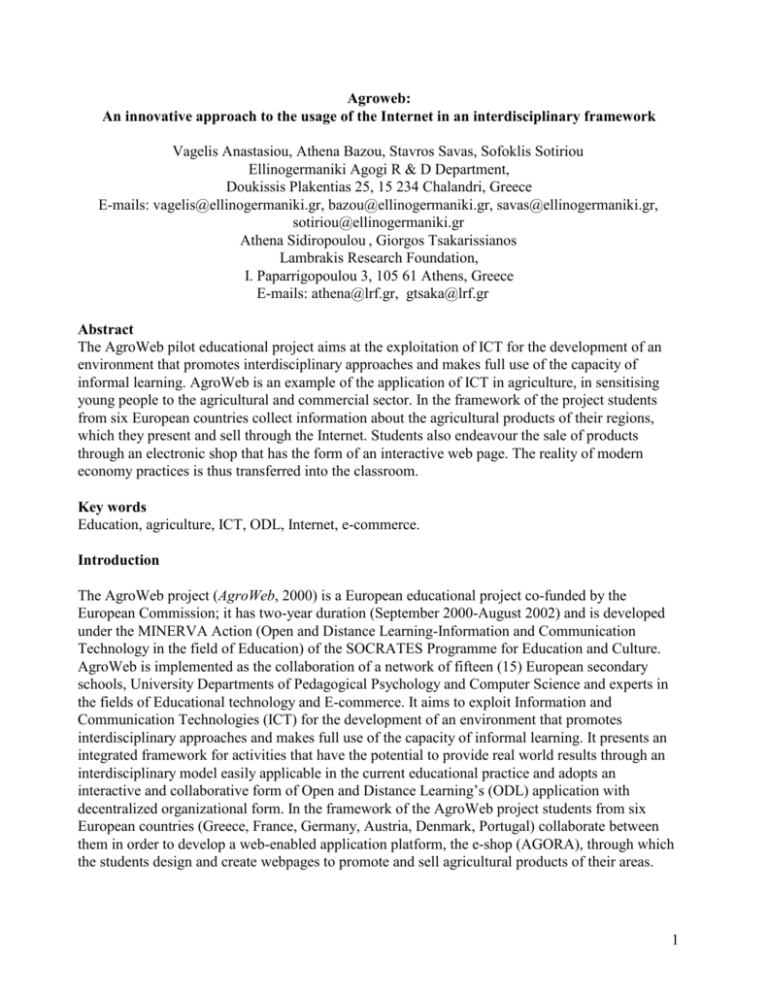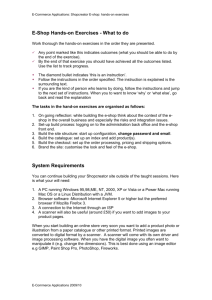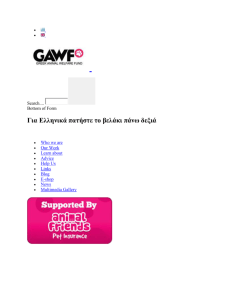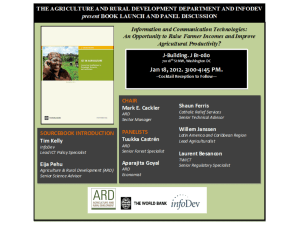Education, agriculture, ICT, ODL, Internet, e
advertisement

Agroweb: An innovative approach to the usage of the Internet in an interdisciplinary framework Vagelis Anastasiou, Athena Bazou, Stavros Savas, Sofoklis Sotiriou Ellinogermaniki Agogi R & D Department, Doukissis Plakentias 25, 15 234 Chalandri, Greece E-mails: vagelis@ellinogermaniki.gr, bazou@ellinogermaniki.gr, savas@ellinogermaniki.gr, sotiriou@ellinogermaniki.gr Athena Sidiropoulou , Giorgos Tsakarissianos Lambrakis Research Foundation, I. Paparrigopoulou 3, 105 61 Athens, Greece E-mails: athena@lrf.gr, gtsaka@lrf.gr Abstract The AgroWeb pilot educational project aims at the exploitation of ICT for the development of an environment that promotes interdisciplinary approaches and makes full use of the capacity of informal learning. AgroWeb is an example of the application of ICT in agriculture, in sensitising young people to the agricultural and commercial sector. In the framework of the project students from six European countries collect information about the agricultural products of their regions, which they present and sell through the Internet. Students also endeavour the sale of products through an electronic shop that has the form of an interactive web page. The reality of modern economy practices is thus transferred into the classroom. Key words Education, agriculture, ICT, ODL, Internet, e-commerce. Introduction The AgroWeb project (AgroWeb, 2000) is a European educational project co-funded by the European Commission; it has two-year duration (September 2000-August 2002) and is developed under the MINERVA Action (Open and Distance Learning-Information and Communication Technology in the field of Education) of the SOCRATES Programme for Education and Culture. AgroWeb is implemented as the collaboration of a network of fifteen (15) European secondary schools, University Departments of Pedagogical Psychology and Computer Science and experts in the fields of Educational technology and E-commerce. It aims to exploit Information and Communication Technologies (ICT) for the development of an environment that promotes interdisciplinary approaches and makes full use of the capacity of informal learning. It presents an integrated framework for activities that have the potential to provide real world results through an interdisciplinary model easily applicable in the current educational practice and adopts an interactive and collaborative form of Open and Distance Learning’s (ODL) application with decentralized organizational form. In the framework of the AgroWeb project students from six European countries (Greece, France, Germany, Austria, Denmark, Portugal) collaborate between them in order to develop a web-enabled application platform, the e-shop (AGORA), through which the students design and create webpages to promote and sell agricultural products of their areas. 1 Description Objectives The main objectives of the AgroWeb project are: The development of an interdisciplinary model in current educational practice. The interdisciplinarity is very important, since it provides a unique way of strengthening learning processes, such as discovering analogies, similarities etc., while providing topics, which are inherently closer to real world problems. Educational context of AgroWeb is not transmitted in a theoretical way but rather in a biomatic way in the form of a real life experience. Students become entrepreneurs finding, promoting, marketing and selling agricultural products from their local areas. During all stages of this procedure the students acquire knowledge and skills on subjects such as language and culture, history, geography, mathematics and economics. This interdisciplinary “realworld” educational concept is materialized with the specially developed electronic shop (e-shop). The e-shop is the electronic AGORA, the meeting point of all transactions and exchanges of ideas, the place where the European single market and the importance of the European single currency, the EURO is realized in praxis. This is very important since the European single market is a challenge for Europe, as the European Union is an attractive market of 370 million people with one single currency. In this way students are not only educated in the economy and marketing practices but also realize the fundamental changes taking place in the European common market with the introduction of the common currency. The presentation of Europe’s agricultural diversity through the use of ICT. One of the essential points in the European integration is understanding and respecting diversity. Through the participation to the AgroWeb project students have the chance to realize that this important parameter in the European continent, diversity, exists even in the agricultural sector. Technology is often accused of displacing the cultural aspects of education. In the contrary the AgroWeb project exploits the unique marketing and distribution capabilities Internet offers. Students through the creation of descriptive webpages get to know particular foreign products, such as for the Austrian Topfenstangerl or the Greek pastelli. The provision of a model for motivating and integrated activities in the classroom. It is common knowledge among educators that activities with high student participation have a unique potential for providing motivating topics in the classroom and enhancing the quality and the effectiveness of education (Todt Eberhard, 1993). In the framework of the AgroWeb project students are asked to collect appropriate and "marketable" content on the products they sell electronically, in order to present them on the Web. The "marketability" of the content is especially innovative since it provides a very motivating aspect in the whole procedure. Moreover, students involved in the project acquire tele-working experiences, organizational and management skills that are key competencies for tomorrow' s European workers. The provision of a model for the usage of ICT in schools. Students and teachers should be trained in discovering the "real world" implications of the Internet and planning the design of their webpages accordingly. The AgroWeb project is an example of the application of ICT in agricultural education, in sensitising young people to the agricultural and commercial sector. The more 2 experienced students will grow to be the leaders (entrepreneurs or consumers) in the agri-food sector. During the project’s implementation students of the participating schools use the capabilities that Internet offers to promote the traditional agricultural products of their areas, to commercialize them on the web following a business and media coverage plan. The developed e-shop is not only used as a distribution center of goods but also as an educational tool providing facilities of monitoring the performance of each product in the market in a graphical way. It should be stressed though that the whole setup as such provides strong incentives for actual tele-working, not merely for the provision of content over distance. The selection of roles in the whole process brings the best out of students’ skills and serves as an initiation to a vocational training according to the contemporary demands of the market. The familiarization of teachers with ICT and ODL. One of the project’s aims is to provide teachers with effective training that accustoms them to the use of modern ICT and allows for the incorporation of ODL elements in their teaching practice. Emphasis is given to motivation problems, ability to handle ICT and evaluation and monitoring techniques of the implemented activities. The training seminars themselves are organized according to an ODL scheme. The material of the seminars, trainees’ contributions, questions and answers are constantly fed to the project web’s site so that a transnational dialogue, via bulletin boards and extended use of low cost videoconference through the Internet, is stimulated. The seminars provide the teachers with the necessary theoretical background but also offer a series of examples of “good practice” applications. The provision of arguments in favour of ODL’s spread in secondary education. Students participating in the project benefit from the enhanced participation and interactivity that the introduction of ODL offers to the “conventional” teaching. The evaluation of AgroWeb project is a matter of great importance since only a few ODL projects have been systematically evaluated so far. The monitoring strategy includes both quasi-experimental test and on-field observation. The research process adopted includes all the steps of the scientific inquiry. From this evaluation scheme arguments in favour of the need for wider spread of ODL practices in secondary education are expected to arise, arguments that are to be distributed through an extended dissemination plan. Pedagogical principles The AgroWeb project is being developed across three main pedagogical principles: Learning should be a collaborative experience. The project is based on the creation of a “virtual classroom” (Jonassen et al., 1995). All groups from each school form a single classroom whose members collaborate in every stage of the project’s implementation through the e-shop (AGORA). The collaboration between students is a prerequisite for the success of the project, as they allocate the workload with their virtual classmates either horizontally, e.g. across activities such as digitization of the content, or vertically, e.g. across products, in order to implement all kinds of activities (Apostolakis et al., 1999). Moreover, students’ world state friendship can be busted only if based on a person- to-person contact. This can best be achieved when people from different nations work together with common aims and objectives and collaborate, as the students participating at the AgroWeb project do in daily basis. 3 Participation enhances learning. It is widely held that increased students’ participation stimulates interest (Gangoli et al., 1995). AgroWeb provides students with experience in a collaborative, interdepartmental, and international project that emphasizes on agricultural products, marketing and ICT. Educational context of AgroWeb is not transmitted in a theoretical way but rather in a biomatic way in the form of a real life experience, as students participate in every stage of the project giving direction to it. Need for cross curricula approach. As mentioned, interdisciplinarity is crucial towards enhancing the effectiveness of education. During all stages of this procedure students acquire knowledge and skills on subjects such as language and culture, history, geography, mathematics and economics. At the same time they learn about European agricultural products and become familiar with e-commerce and the common currency. For instance students collect information on the history of the wine and the oil that are produced in their areas (in the framework of the history class). Simultaneously they investigate relevant chemical and ecological data and other special features about the products they promote (in the framework of the chemistry class). They design attractive trademarks of the products to commercialize them in the most efficient way (in the framework of their art class). Finally the performance of the products is monitored with the use of the additional features of the e-shop platform (in the framework of the civic economics class), giving students the opportunity to evaluate the planned strategy and modify the business plan accordingly. Student Activities In the framework of the project students are asked to collect information on traditional agricultural products that played a significant role in the history and in the socioeconomic development of the area. Then, the students create "marketable" content on the products they are going to sell electronically, in order to present them on the web (see Figure 1). Figure 1: The map of Europe and the categories of the products promoted through the e-shop. Following the selection of the most representative products, students negotiate with the local producers for the acquisition of a limited amount of products in exchange of promoting them in the Internet in the framework of the project. Following, in the framework of the art class, they design 4 attractive trademarks of the products to commercialize them in the most efficient way. In parallel with the presentation and promotion of products the students try to illustrate the characteristics of their regions, like customs, traditions, geographical and climatological particularities. Students develop a business plan for each product including all the appropriate stages: market research, price determination, distribution and promotion policies with emphasis to the use of new media and future perspectives. Students also have the possibility to comment on the project and influence the continuous development of the e-shop platform. They also determine "bundling" policies together with their virtual classmates in the other European countries in order to attract the consumer who wants to sample a basket of various European goods. At the same time students study, analyse, and finally compare the performance of the products with the targeted performance according to the original business plan. Students also endeavour to sell the products through an electronic shop that has the form of an interactive web page. During “e-shopping” the performance of the products in the virtual market is monitored on a weekly basis using the additional features of the e-shop platform. Virtual classmates have the opportunity to easily compare the different promotion strategies followed in different countries, evaluate them and through discussions (in the bulletin board or through low cost videoconferencing through the Internet) identify the factors that affect the sales of products. They can then respond immediately and modify their strategies accordingly and finally study the impact of their decisions. This comparison forms the stimuli for a dialogue with virtual classmates through various communication channels the e-shop platform offers. Students also present their products as well as their commercialization strategies in a bulletin that is published during the project’s run. The six issues of AgroWeb magazine are published both in electronic and conventional form, so that students not actively participating to the project are constantly informed as well about the project’s activities. Parents and the wider public are also informed about the results of the project through the magazine. The implementation of the project in the classroom takes place in two phases. In the first phase seven (7) European high schools (partner schools) have participated. This was the test run and took place from January to May 2001. The students tested the “user-friendliness” of the e-shop platform and gave their input for its improvement. During the second phase, the final run, the number of schools was increased to fifteen (15), to form an expanded European school network with schools of various types (general conventional schools, farm schools, business schools); all transactions were made in Euro. The school activities of the final run had a duration from October 2001 to May 2002. The Agricultural E-Shop The above-mentioned procedure is facilitated through the use of the electronic shop, the Agora, which, as it has been mentioned, is not just a simple place for the transaction of goods. The Agora is the “e-store shelves” for the presentation and sales of the products and in parallel the tool providing the pedagogically-designed communication -forum enabling the intense interaction and communication of the virtual classmates. Its overall appearance was evaluated by the students themselves during the test run and accordingly necessary adjustments were made before the final run. It is of major importance to ensure that the e-shop’s user interface (see Figure 2) is attractive to 5 the ages targeted by the project. The use of cutting edge technology in the construction of electronic tool is not the first priority. The main task is to use existing technology in the best way in order to produce a pedagogically suitable and attractive user interface. Figure 2: The interface of the AgroWeb e-shop. Some of the facilities of the e-shop platform include tools for graph production (the sales of a product), tools to compare graphically actual and anticipated performances and in general what is necessary to monitor the financial activities of a real shop (see Figures 3a, 3b). Finally the e-shop platform is made attractive and user friendly to users and this is achieved by following four principles during its development: it should provide easy access, interactivity to stimulate the user’s implication; it should present variety in the range of activities and should create a motivating learning environment. Two main objectives were targeted for performance metrics. First, to address clear educational needs such as familiarization with graphical representations and determination of which quantities depend on each other and second, to guaranty full freedom of the students in choosing the form of graphical representation. Figures 3a, 3b: Graphical representations. Students are able to see the distribution per country of the products sold and compare the actual sales of the products versus the estimated sales. 6 Agora is also a means of communication for students from different European countries. Students communicate with their virtual fellow students and get to know the products of other regions as well as the cultural and social elements related to them. Consequently, the e-shop platform, has international reach. Agora is therefore a multidynamic meeting place and a place for the exchange of ideas. Innovation The AgroWeb project realizes an innovation in school education, targeting the meaningful application of ICT in an interdisciplinary approach of the learning process. It also initiates necessary measures to prepare students for their future active participation in e-commerce, since it can be expected that this new form of commerce will rapidly increase and represent a common practice in Europe’s near future. An innovative moment of the AgroWeb project is the use of the Internet not only as information tool but as an instrument to help students practice transnational marketing and commerce. Through the creation of a virtual classroom the students have the chance to actively participate in the electronic AGORA, marketing European agricultural goods through the AgroWeb’s e-shop. The Internet in the AgroWeb project, through the development of the suitable platform, is used as a communication tool for collaborative learning. The exchange of content between students of different European schools like the exchange of content on the agricultural products including cultural and geographical details stimulates collaborative activities like the design over distance of a common marketing strategy for different European goods. Finally, the interdisciplinary approach is highly innovative as well, not only by means of connecting learning processes of various disciplines as geography, mathematics, new technologies, economics etc. in the common framework of one project, but by also connecting non technical activities, as the planning and implementation of a marketing and distribution policy, safeguarding sustainability of agricultural products making use of ICT tools, thus creating bridges between tradition and new technologies in modern life. Evaluation The evaluation of the AgroWeb project is also a matter of great importance since only a few ODL projects have been systematically evaluated so far (Savas et al., 1998). The project’s run is evaluated in a concrete scheme. The evaluation of the impact of the adapted didactical approach is performed by the scientific groups of the Department of Philosophy and Human and Social Sciences of the University of Picardie in Amiens, France and of the Department of Psychology of the University of Frankfurt am Main, Germany. The research process that has been adopted includes all the steps of the scientific inquiry, namely the problem statement, the exploratory question (hypothesis), the description of the procedure, the sample, the measurements, the tests (pre- and post-) and the data analysis. The approach selected is the quasi-experimental one (Hays, 1973). It includes both measurements (pre- and post-tests) and on-field observation for educators and students. A two-group (experimental and control group) design is adopted for the measurements. The data from the control group are included in the analysis in order to minimize the effects of normal development and aging. Simultaneously the attitude of the students towards 7 foreign students is investigated. The data are statistically analyzed with numerical methods and the results are systematically evaluated. Special emphasis has been given to the development of the evaluation scheme in order to overcome difficulties associated with the relatively small number of students involved and the limited duration of the implementation in classroom, which is the case for such educational pilot projects. The research plan for the project’s evaluation is based on the following key features: the exact determination of learning objectives, the systematic data acquisition during both phases of implementation, the introduction of a methodological reporting system and the combination of quantitative and qualitative results. From this accurate evaluation scheme arguments in favor of the need for the awareness of children to the agricultural and cultural diversity of Europe as well as for the spread of ODL practices in secondary education are expected to arise. Conclusion The AgroWeb project targets the long-term effect on students’ behavior as active players on the European market. This is achieved in the project by the transmission of skills and critical knowledge to face the challenge of ICT practices in today’s and even more tomorrow’s daily life of European citizens, including the motivation to constantly up-date their knowledge and to accept life-long learning. The “AgroWeb e-shop” itself as sustainable outcome of the project may be maintained as a well functioning e-commerce tool by interested parties after the project’s ending. The specific approach makes AgroWeb project an example of good practice concerning the use of ICT for the promotion of agribusiness, which can be extended to adults. References 1 AgroWeb project: The project is developed within the framework of the MINERVA Action of the European Commission (Cr no: 88172-CP-1-2000-1-GR-MINERVA-ODL). 2 Apostolakis et al., (1999) The e-Hermes project. Open Distance Learning in secondary education, ed. EPINOIA, Chalandri, Greece. 3 Gangoli S., Gurumurthy C., (1995) “A study of the effectiveness of a guided open-ended approach to physics experiments”, International Journal of Science Education, Vol. 17, No. 2, pp. 233-241. 4 Hays W., (1973) Statistics for the social sciences, New York: Holt, Rinehart & Winston. 5 Jonassen D., Davidson M., Coolins M., Cambell J., Bannan Haag B., (1995) “Constructivism and Computer-Mediated Communication in Distance education.” The American Journal of Distance education, 9 (2), p. 7. 6 Savas S. et al., (1998) “The e-Hermes project: Interactive forms of distance learning in secondary education”, EDEN conference, Bologna, Italy. 7 Todt Eberhard, (1993) “Schuelerinteressen im Physikunterricht in der Sekundarstufe I.” Physuk in der Schule, Vol. 30, No. 3, pp. 94-97. 8




